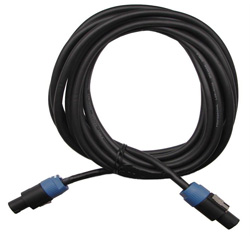
How can these problems be addressed?
The number of strange designs for loudspeaker cable is amazing. Among them are coaxial, with two insulated spiral “shields” serving as conductors; quad, using two conductors for “positive” and two for “negative;” zip-cord with ultra-fine “rope lay” conductors and transparent jacket; multi-conductor, allegedly using large conductors for lows, medium conductors for mids, and tiny conductors for highs; 4 AWG welding cable; braided flat cable constructed of many individually insulated conductors; and many others.
Most of these address the inductance question by using multiple conductors and the skin effect problem by keeping them relatively small. Many of these “esoteric” cables are extraordinarily expensive; all of them probably offer some improvement in performance over ordinary twisted-pair type cables, especially in critical monitoring applications and high-quality music systems. In most cases, the cost of such cable and its termination, combined with the extremely fragile construction common to them, severely limits their practical use, especially in portable situations.
In short, they cost too much, they’re too hard to work with, and they just aren’t made for rough treatment. But, sonically, they all bear listening to with an open mind; the differences can be surprisingly apparent.
Is capacitance a problem in loudspeaker cables?
The extremely low impedance nature of speaker circuits makes cable capacitance a very minor factor in overall performance. In the early days of solid state amplifiers, highly capacitive loads (such as large electrostatic speaker systems) caused blown output transistors and other problems, but so did heat, short circuits, highly inductive loads and underdesigned power supplies.
Because of this, the dielectric properties of the insulation used are nowhere near as critical as that used for high-impedance instrument cables. The most important consideration for insulation for loudspeaker cables is probably heat resistance, especially because the physical size constraints imposed by popular connectors like the ubiquitous 1/4-in phone plug severely limit the diameter of the cable.
This requires insulation and jacketing to be thin, but tough, while withstanding the heat required to bring a relatively large amount of copper up to soldering temperature. Polyethylene tends to melt too easily, while thermoset materials like rubber and neoprene are expensive and unpredictable with regard to wall thickness PVC is cheap and can be mixed in a variety of ways to enhance its shrink-resistance and flexibility, making it a good choice for most applications. Some varieties of TPR (thermoplastic rubber) are also finding use.
Why don’t loudspeaker cables require shielding?
Actually, there are a few circumstances that may require the shielding of loudspeaker cables. In areas with extreme strong radio frequency interference (RFI) problems, the loudspeaker cables can act as antennae for unwanted signal reception which can enter the system through the output transistors. When circumstances require that loudspeaker-level and microphone-level signals be in close proximity for long distances, such as cue feeds to recording studios, it is a good idea to use shielded loudspeaker cabling (generally foil-shielded, twisted-pair or twisted-triple cable) as “insurance” against possible crosstalk form the cue system entering the microphone lines.
In large installations, pulling the loudspeaker cabling in metallic conduit provides excellent shielding from both RFI and EMI (electromagnetic interference). But, for the most part, the extremely low impedance and high level of loudspeaker signals minimizes the significance of local interference.
Why can’t I use a shielded instrument cable for hooking an amplifier to a loudspeaker, assuming it has the right plugs?
You can, in desperation, use an instrument cable for hooking up an amplifier to a loudspeaker. However, the small gauge (generally 20 AWG at most) center conductor offers substantial resistance to current flow, and in extreme circumstances could heat up until it melts its insulation and short-circuits to the shield, or melts and goes open-circuit, which can destroy some tube amplifiers.
Long runs of coaxial-type cable will have large amounts of capacitance, possibly enough to upset the protection circuitry of some amplifiers, causing untimely shut-downs. And of course there is enormous power loss and damping degradation because of the high impedance of the cable.
BIBLIOGRAPHY
• Ballou, Greg, ed., Handbook for Sound Engineers: The New Audio Cyclopedia, Howard W. Sams and Co., Indianapolis, 1987.
• Cable Shield Performance and Selection Guide, Belden Electronic Wire and Cable, 1983.
• Colloms, Martin, “Crystals: Linear and Large,” Hi-Fi News and Record Review, November 1984.
• Cooke, Nelson M. and Herbert F. R. Adams, Basic Mathematics for Electronics, McGraw-Hill, Inc., New York, 1970.
• Davis, Gary and Ralph Jones, Sound Reinforcement Handbook, Hal Leonard Publishing Corp., Milwaukee, 1970.
• Electronic Wire and Cable Catalog E-100, American Insulated Wire Corp., 1984.
• Fause, Ken, “Shielding, Grounding and Safety,” Recording Engineer/Producer, circa 1980.
• Ford, Hugh, “Audio Cables,” Studio Sound, Novemer 1980.
• Guide to Wire and Cable Construction, American Insulated Wire Corp., 1981.
• Grundy, Albert, “Grounding and Shielding Revisited,” dB, October 1980.
• Jung, Walt and Dick Marsh, “Pooge-2: A Mod Symphony for Your Hafler DH200 or Other Power Amplifiers,” The Audio Amateur, 4/1981.
• Maynard, Harry, “Speaker Cables,” Radio-Electronics, December 1978,
• Miller, Paul, “Audio Cable: The Neglected Component,” dB, December 1978.
• Morgen, Bruce, “Shield The Cable!,” Electronic Procucts, August 15, 1983.
• Morrison, Ralph, Grounding and Shielding Techniques in Instrumentation, John Wiley and Sons, New York, 1977.
• Ott, Henry W., Noise Reduciton in Electronic Systems, John Wiley and Sons, New York, 1976.
• Ruck, Bill, “Current Thoughts on Wire,” The Audio Amateur, 4/82.
Thanks to Pro Co Sound for this article.
